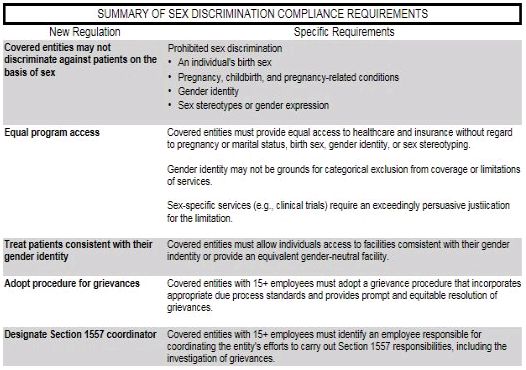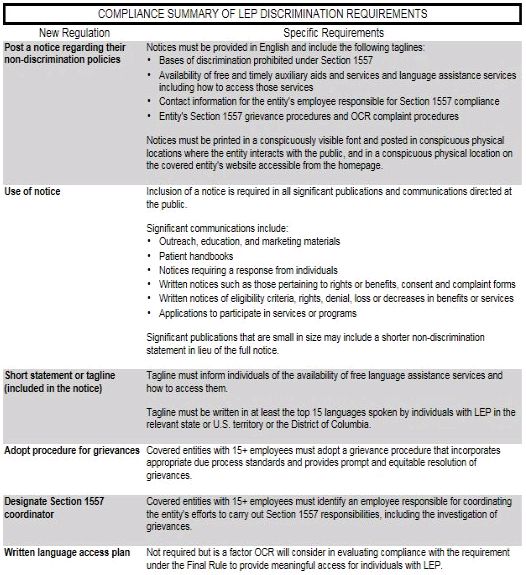- with readers working within the Aerospace & Defence, Property and Telecomms industries
The U.S. Department of Health and Human Services (HHS) moved to the forefront of anti-discrimination measures when it released a final rule, titled "Nondiscrimination in Health Programs and Activities" (Final Rule), implementing Section 1557 of the Affordable Care Act (ACA), which prohibits discrimination on the grounds of race, color, national origin, sex, age or disability in certain health programs and activities. The Final Rule sets out standards for addressing the prohibition against discrimination on the basis of sex in health programs and the application of Section 1557 to HHS-administered health programs. Hospitals and other healthcare providers are required to be in full compliance with the Final Rule by October 16, 2016, but getting up to speed could take some time. This article outlines some of the many requirements healthcare providers will need to implement to comply with Section 1557.
Scope of the Final Rule
The Final Rule implementing Section 1557 applies to any health program or activity that receives funding from HHS, including but not limited to Medicaid or Medicare Parts A, C and D. The Final Rule applies to, among others, providers such as hospitals that accept Medicare or doctors who receive Medicaid payments, the Health Insurance Marketplaces and issuers that participate in those Marketplaces, and any health program that HHS itself administers. Notably, physicians and suppliers participating in Medicare Part B are not subject to Section 1557; however, they may still be required to comply if they accept Medicaid or meaningful use information technology funding (which ends in 2018).
Providers subject to Section 1557 are considered a "covered entity" by HHS, which is certain to cause confusion with HIPAA regulations. Each covered entity applying for federal financial assistance must assure its compliance with Section 1557 and the regulations promulgated under the Final Rule by submitting an Assurance of Compliance form to the Office for Civil Rights (OCR).
The requirements for compliance with Section 1557 are backed with significant enforcement powers. Failure to comply may result in loss of HHS funding, and the Final Rule reiterates that Section 1557 provides a private right of action, either individually or as part of a class action, to those who believe they experienced prohibited discrimination.
Discrimination Based on Sex and Gender
Under the Final Rule, Section 1557 extends the sex discrimination prohibition of Title IX, which previously applied to education, to individuals in healthcare settings and defines sex discrimination to include discrimination on the basis of the following:
- Pregnancy
- False pregnancy
- Termination of pregnancy or recovery from it
- Childbirth
- Marital or familial status
- Sex stereotyping (including the stereotype that an individual must identify as either male or female)
- Gender identity
Gender identity is defined to include identity as "male, female, neither, or a combination of male and female" and may be different from the sex assigned to an individual at birth. Generally, covered entities must treat transgender individuals consistently with their own gender identity. That said, the Final Rule does not prohibit separate men's and women's toilets, locker rooms or shower facilities as long as comparable gender-neutral facilities are available. It does note, however, that individuals may not be excluded from facilities for which they are otherwise eligible based on their gender identity. Sex-specific programs are permitted only with an "exceedingly persuasive justification," such as the scientific need to limit participation in a clinical trial to a particular birth sex assignment.
Despite a progressive approach toward transgender health, the Final Rule does not resolve whether sexual orientation discrimination is prohibited by Section 1557. While HHS "support[s] a prohibition on discrimination based on sexual orientation as a matter of policy," the Final Rule notes that "OCR has decided not to resolve in this Rule whether discrimination on the basis of an individual's sexual orientation status alone is a form of sex discrimination under Section 1557." To that end, HHS "will continue to monitor legal developments in this area," "enforce Section 1557 in light of those developments" and consider issuing further guidance as appropriate.

Discrimination Against Persons With Limited English Proficiency
Entities covered under the Section 1557 rule are required take reasonable steps to provide meaningful access to each individual with limited English proficiency (LEP) who is eligible to be served or likely to be encountered in their health programs and activities. The Final Rule incorporates existing requirements of Title VI of the Civil Rights Act of 1964 and HHS LEP policy guidance and outlines specific requirements related to provision of language assistance services.
Notice Requirement
One of the more significant new mandates in the Final Rule is the requirement that each covered entity posts a notice regarding its non-discrimination policies. These notices must be provided in English with multi-lingual taglines and include:
- Bases of discrimination prohibited under Section 1557;
- Availability of free and timely auxiliary aids and services and language assistance services, including how to access those services;
- Contact information for the entity's employee responsible for Section 1557 compliance; and
- Entity's Section 1557 grievance procedures (if applicable) and OCR complaint procedures.
All significant publications and communications directed at the public must include such notice. In guidance accompanying the release of the Final Rule, OCR provided a sample notice and indicated that it views "significant communications" as including the following:
- Outreach, education and marketing materials;
- Patient handbooks;
- Notices requiring a response from individuals;
- Written notices such as those pertaining to rights or benefits;
- Consent and complaint forms;
- Written notices of eligibility criteria, rights, denial, loss or decreases in benefits or services; and
- Applications to participate in services or programs.
Tagline Requirement and Language Assistance Services
Each covered entity must include taglines in at least the top 15 languages spoken by individuals with LEP in the applicable state, District of Columbia or U.S. territory, notifying such individuals of the availability of language assistance services.
Covered entities are responsible for providing language assistance services, such as oral interpretation and written translation, even if the language is not shown on OCR's list, when doing so is a reasonable step to provide meaningful access to an individual with LEP. These services must be provided free of charge and protect individuals' privacy and independence. Individuals with LEP cannot be required to provide their own interpreters, and a covered entity may not rely on an adult accompanying the individual or a minor child to provide these services. Rather, covered entities must use qualified translators and interpreters. Services must be provided in a "timely manner," but the Final Rule does not include prescriptive time frames.

The content of this article is intended to provide a general guide to the subject matter. Specialist advice should be sought about your specific circumstances.



